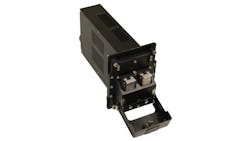Navy chooses encrypted data storage from Physical Optics for the trusted computing needs of combat jets
PATUXENT RIVER NAS, Md. – U.S. Navy air warfare experts needed encrypted data storage and transfer units for carrier-based F/A-18E/F fighter-bombers and EA-18G electronic warfare jets. They found their solution from Physical Optics Corp. in Torrance, Calif.
Officials of Naval Air Systems Command at Patuxent River Naval Air Station, Md., announced a $27.2 million order to Physical Optics last week to build 160 data transfer units and 160 ground data transfer units in support of the Navy's F/A-18 E/F and EA-18G program.
The Physical Optics Data Transfer Unit is a high-capacity data, video, and audio loader and recorder for the trusted-computing needs of fixed-wing aircraft and helicopters that uploads mission and map data, records in-flight avionics data, and records maintenance data during ground and flight operation for post flight information exchange.
The order includes 14 maintenance access cables, 600 mission data transfer devices, and 459 maintenance data transfer devices, and includes 37 data transfer units, 35 ground data transfer units, 11 maintenance access cables, 122 mission data transfer devices, and 90 maintenance data transfer devices for the Kuwait Super Hornet program.
Related: Secure data storage for battlefield networking
These units serve as the transportable data storage medium for -pre- and post-mission information exchanges between the mission planning system, maintenance ground station, and the aircraft.
The Physical Optics Data Transfer Unit can handle encrypted and non-encrypted data, and transfers with the system's data transfer devices, each one containing 128 gigabytes of memory storage. The system uses three independent removable memory units (RMUs) for data storage with a capacity of 128 gigabytes each, expandable to 512 gigabytes.
The Physical Optics Ground Data Transfer Unit G-DTU is a ground-based docking station that interfaces to the military's Joint Mission Planning System (JMPS) and Aviation Mission Planning System (AMPS) ground station via a standard USB cable and uploads and downloads and download data onto and off of aircraft. Data to and from the JMPS/AMPS is encrypted and decrypted by the G-DTU and then is written to or read from the data transfer device (DTD).
Data recorded from the aircraft is decrypted by the G-DTU prior to transmission of the data to JMPS/AMPS. The G-DTU uses the same encryption/decryption algorithms as the DTU. The G-DTU is compatible with a variety of aircraft transfer systems.
On this contract Physical Optics will do the work in Torrance, Calif., and should be finished by August 2021. For more information contact Physical Optics Corp. online at www.poc.com.

John Keller | Editor-in-Chief
John Keller is the Editor-in-Chief, Military & Aerospace Electronics Magazine--provides extensive coverage and analysis of enabling electronics and optoelectronic technologies in military, space and commercial aviation applications. John has been a member of the Military & Aerospace Electronics staff since 1989 and chief editor since 1995.

